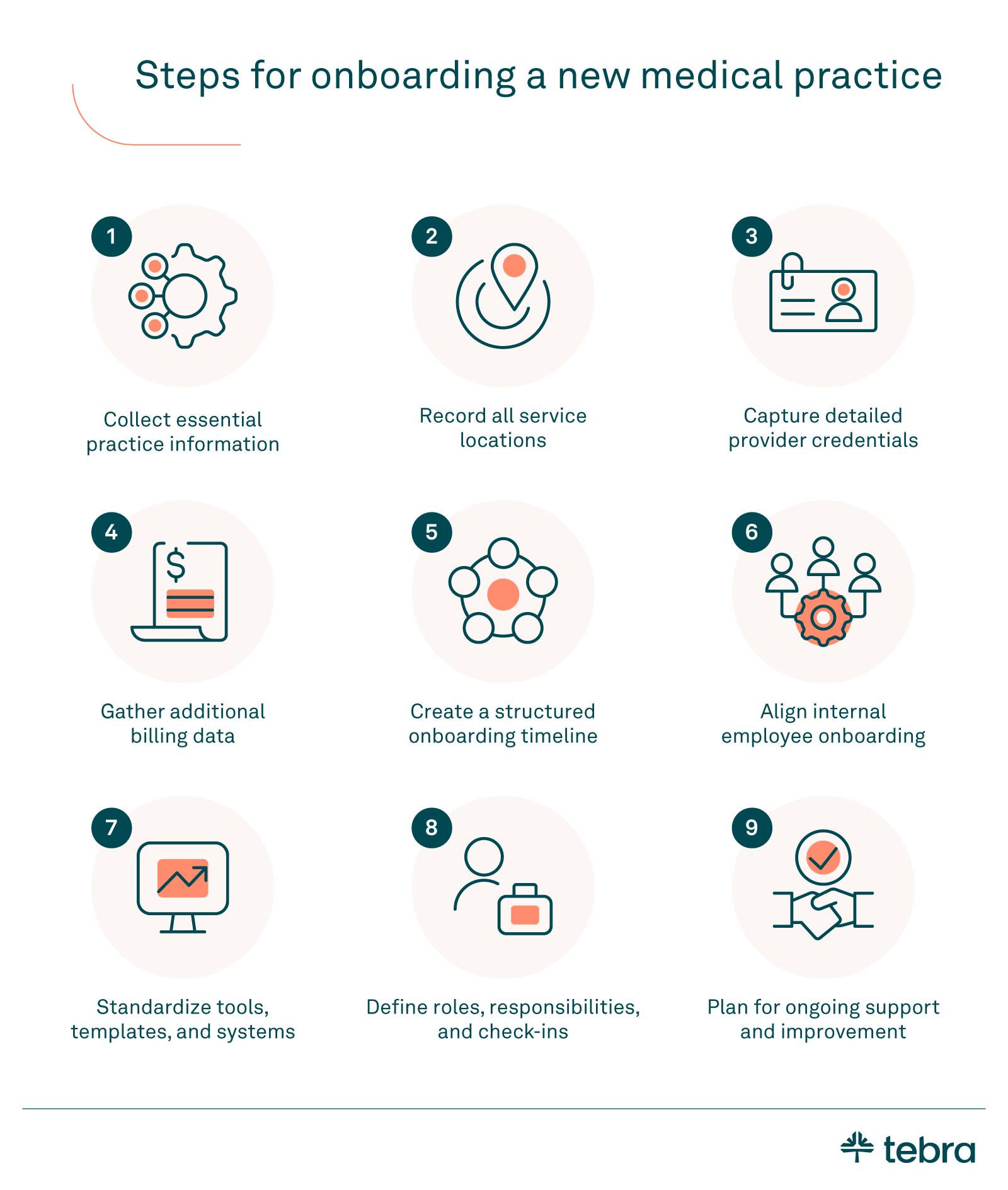
- Comprehensive data collection during onboarding helps streamline future billing and reduce claim rejections. Capture practice, location, and provider details early in your EHR software for consistent records, reducing the cost of back-and-forth.
- Clear documentation of every service location and verified provider credentials supports accurate insurance claims. This foundation keeps payer workflows moving for multi-location practices.
- Teams should review and tailor onboarding forms on a regular cadence. Targeted updates and light automation build strong onboarding habits and stabilize revenue cycle management.
An onboarding company helps new team members integrate through a structured onboarding process that goes beyond orientation. It maps the onboarding journey from preboarding to training and early check-ins. When it works, it delivers successful onboarding that supports engagement and retention.
Whether you're starting a new medical billing company or expanding your business, the first impression matters. How you handle medical billing onboarding with a new practice sets the tone for the rest of your client relationship.
Effective onboarding demonstrates your expertise and commitment to your clients. Your onboarding program also shapes company culture and prepares teams for clean billing and claims.
One vital component of a strong onboarding experience is how you collect essential practice information from new clients. Gathering accurate and complete details in one simple document lets you onboard practices faster and reduce follow-up. The guidance here focuses on private practices in the United States.
This guide helps billing companies streamline the onboarding process so practices can spend more time on what matters most: their patients.
How to successfully onboard a new medical practice
Onboarding a new medical practice requires a structured approach that ensures smooth setup, accurate billing, and lasting client relationships. The steps below help medical billing companies create a consistent, efficient onboarding process from day one.

Collect accurate practice information
Collecting accurate practice information is essential for setting up the correct billing and claims processes. This data establishes the practice's identity in your system and keeps records consistent.
Capture at minimum:
- Practice name
- Main office contact
- Tax ID
- Group NPI
- Practice address (with 9-digit ZIP)
- Pay-to billing address
Review this information before you close onboarding to prevent delays with payers. Accurate practice data simplifies recordkeeping and supports provider setup later in the flow. Structured fields also enable real-time eligibility checks and downstream functions across your tools. Standardize collection with templates and an onboarding checklist so teams gather the same details every time.
Download your free resource now
Access it instantly — just complete the form

Record all service locations
Record every service location during onboarding to prevent claim denials and routing errors. Payers expect the correct place-of-service on each line, so the details you collect here protect clean submissions and faster payments.
For each location, capture at minimum:
- Site name
- Complete address
- Any unique identifiers
This information helps you manage multi-location practices, track site-level performance, and send claims to the right payer on the first pass. When locations are stored as structured fields, they connect to billing workflows and reporting modules. Your team also gains a reliable workspace for eligibility checks, claim routing, and location-specific follow-up.
Capture detailed provider credentials
Collecting individual provider details makes sure that each clinician has the right credentials and helps your team submit clean claims. It also speeds up payer review and makes follow-up easier.
Capture at minimum:
- Provider name
- NPI
- EIN/SSN
- Email address
For Medicare billing, complete enrollment in PECOS and obtain a PTAN when required. Review CMS guidance in Become a Medicare Provider or Supplier and the PECOS fact sheet for current steps and documentation.
Use real-time status checks in payer portals to confirm active participation and avoid avoidable denials. When appropriate, include basic identity and credential background checks in your intake so you can resolve mismatches before claims go out.
Gather additional billing data
Capture the following during onboarding so detailed information is available later and processes match the practice's needs.
- Contracted insurances help you apply payer rules and avoid out-of-network issues.
- Payer websites and portals support eligibility checks, claim tracking, appeals, and other payer functions.
- A PTAN speeds Medicare billing and supports PECOS enrollment verification when needed.
- A fee schedule provides accurate pricing for services by the payer.
- A self-pay fee schedule supports consistent patient collections for cash visits.
- A written financial policy for no-shows clarifies fees and approved adjustments.
- Provider-specific claim overrides allow fast handling of known exceptions.
- CLIA certification provides the correct submission for lab claims.
- ERA/EFT setup with a bank letter or voided check and a W-9 routes electronic payments to the correct account and completes payer enrollment requirements.
Storing these fields as structured data in your billing and EHR tools keeps everything reusable and searchable across your software solution.
Build a structured onboarding program
Treat onboarding as a simple timeline that begins before the contract is signed. Preboarding starts with a single packet that requests practice, location, and provider details. Confirm contacts, payer mix, and fee schedules. Share a short agenda so everyone knows what to expect on day one.
- On the first day: Walk the practice through your standard onboarding workflows. Validate eligibility steps, claims routing, and basic reports.
- Over the first two weeks: Assign owners for key onboarding tasks and set short check-ins. Keep meetings short and focused. Capture open items in a running list so nothing slips.
- After the first month: Review performance, close gaps, and update forms and SOPs. Offer ongoing support with a clear contact path and a simple escalation rule. Reinforce habits that create strong onboarding results, like verifying coverage before each visit and tracking remits weekly.
The right tools make this easier. Link eligibility, claim scrubbing, and payment posting through your medical billing software. Real-time eligibility and cleaner edits reduce denials and shorten days in A/R. Keep the process consistent, document each step, and refine it with every new client.
Align internal onboarding for new hires
Strong client onboarding starts inside your billing company. When you invest in new hires with a clear employee onboarding plan, you reduce errors and speed handoffs. Use a documented employee onboarding process to reinforce company culture and improve the employee experience.
To align your internal onboarding process with client success, focus on these foundational practices:
- Use an HRIS or onboarding software. HR teams can track forms, verify background checks, and keep compliance current through offboarding.
- Assign mentors and hold hiring managers accountable. Practical mentorship gives new team members confidence and supports in-person shadowing when possible.
- Publish a checklist of onboarding tasks. Include scheduled check-ins during the first 30 days to support employee engagement and reduce rework.
- Measure retention by team. Tie scores to client onboarding quality so leaders can coach and improve.
This alignment reduces training drift and accelerates client results. It also makes handoffs predictable.
Standardize tools, templates, and systems
A repeatable setup keeps every client onboarding clean and predictable. Use shared assets and connected tools so data stays accurate and teams move faster.
To keep onboarding consistent and scalable across clients, rely on shared tools and structured systems like these:
- Standardize templates. Create intake packets, checklists, and SOPs as reusable templates. Version them, store centrally, and keep owners assigned.
- Adopt a scalable onboarding platform. Pick a scalable onboarding platform or onboarding solution that governs documents, permissions, and tasks. Keep training inside your onboarding software so updates reach everyone.
- Connect with an API for real-time sync. Tie payer rules, fee schedules, and eligibility to source systems through an API. Aim for real-time updates to cut manual edits and lost changes.
- Unify in an all-in-one system. Centralize scheduling, documentation, and claim prep in an all-in-one EHR so teams work from one record. Use reporting to optimize handoffs and spot gaps.
This approach keeps onboarding workflows consistent, reduces rework, and supports audit-ready records for every client.
Define roles, responsibilities, and check-ins
Clear ownership during onboarding prevents delays and dropped tasks. Assign internal and client-facing responsibilities using the following breakdown:
- Internal figures (e.g., hiring managers) onboard new team members, assign tracked onboarding tasks, schedule skills training on core system functions, and pair a mentor. They also hold short daily stand-ups in week one and weekly check-ins for the first month.
- Client-facing figures (e.g., account leads) gather documents, verify payer setup, and coordinate go-live steps with practice team members. They log issues, confirm fixes, and run scheduled check-ins with the practice until handoff.
- Both sides keep a single tracker, document decisions, and escalate blockers within one business day. They close onboarding after a readiness review and confirm owners for ongoing support.
Plan for ongoing support and continuous improvement
Plan ongoing support with a simple cadence. In month one, hold a weekly touchpoint, then move to monthly reviews. Track open issues, response times, and fixes in one shared workspace so everyone sees progress.
Hand off FAQs to the practice early. Build a short, searchable list for eligibility, claim edits, and payment posting. Include contacts, hours, and steps. Update entries after each resolved ticket so answers stay current.
Measure client retention and service quality on a regular schedule. Review remit trends, denial reasons, and time to payment. Ask for brief feedback after key milestones. Use the results to refine intake, training, and playbooks. Aim for a steady work environment where teams know owners, next steps, and how to escalate.
Common pitfalls checklist
Avoid issues that slow teams and delay payments. Use this list as a cross-check during the onboarding journey.
- Missing payer data. Claims fail when contracted plans, IDs, and addresses are incomplete. Verify against payer portals before first submissions.
- Unmapped locations. Place-of-service codes and addresses must match each rostered site. Confirm every location in the system.
- Incomplete provider enrollment. NPIs, PTANs, and reassignments must be active. Run status checks and file proofs.
- Skipping QA on test claims. Test a small batch before going live. Build this step into your structured onboarding checklist.
- Weak handoff. Handoffs stall without clear contacts and SLAs. Set owners and review dates to ensure successful onboarding.

Make onboarding smooth from day one
Accurate intake data keeps workflows clean from eligibility to payment posting. When teams capture the right details and store them consistently, edits drop and claims move faster. Light automation removes repetitive steps and gives staff more time for patient care.
Keep the process simple. Use short reviews, shared trackers, and clear owners. Close gaps quickly and document what works. These habits build successful onboarding and steady client relationships. Need a fast way to collect client information during onboarding? Download our Quickstart Worksheet to gather everything you need without missing a step.
FAQs about onboarding a new practice
You might also be interested in
Benchmarks for your medical billing company: Get an inside look at revenue models, operations, and industry trends gathered from 100+ independent medical billing companies in our medical billing benchmark report.
- Current Version – Oct 28, 2025Written by: Jean LeeChanges: This article was updated to include the most relevant and up-to-date information available.







